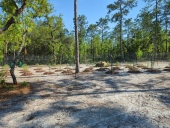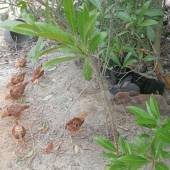I recommend two scenarios if you´d like to harvest crops from the companion plants or just amend the soil in the meanwhile.
The clover is also a great idea for ground cover for most scenarios with beehives.
Harvest (basically turn the orchard into a food forest while the trees start fruiting):
You could place a corn, quinoa, and kale along a few peas/lentils/beans for each plant. Also venture into having pineapples as the plant will survive light frost. The kale and quinoa can be planted in batches to ease the harvest and the plants do survive freezing temperatures.
As a ground cover I would keep the clover and add mustard
If you´d like to have some root crops, you could directly plant burdock, carrots, parsnip, turnips. And make a few towers of 1'x1"x(6-12") squares to grow any type of potatoes vertically.
Also, high heat of the summer and water consumption can be avoided with cassava or banana plants in wicking beds/spots to provide shade while the trees and bushes harden.
Amending:
Keep on planting clover, add all types of legumes and aromatics to chop and drop them.





